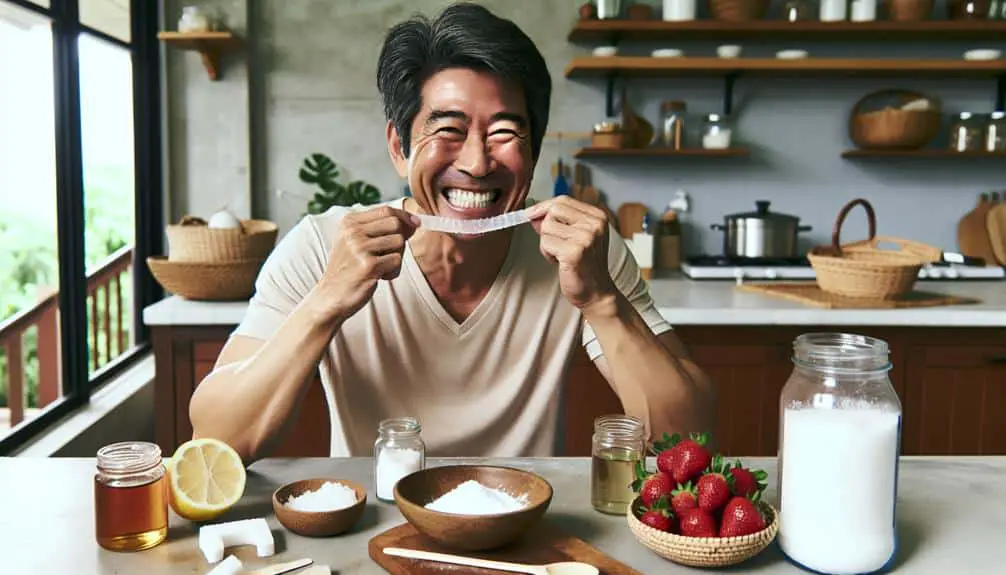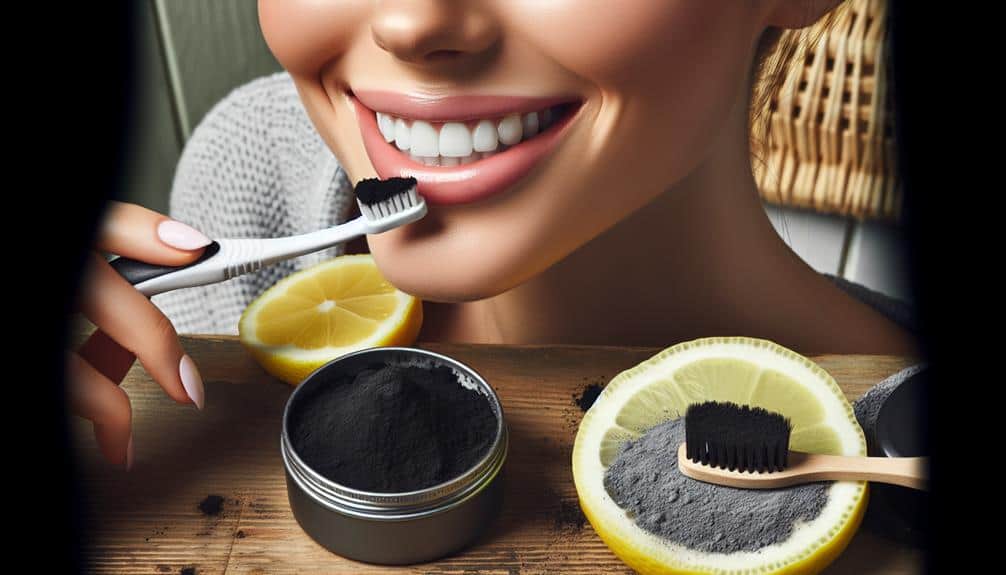Whiten your teeth effectively at home by making DIY teeth whitening strips using common household ingredients like baking soda and hydrogen peroxide. Mix a paste, coat strips evenly, mold them to your teeth, and leave them on for 30 minutes before rinsing for a brighter smile. Prioritize oral health, consult a dentist, and be cautious of abrasive ingredients, as overuse may lead to sensitivity. Follow these steps and safety tips for a cost-efficient way to achieve a whiter smile, with more tips available for long-lasting results by exploring further.
Key Points
- Use natural ingredients like baking soda and hydrogen peroxide for safer whitening.
- Create custom whitening strips with aluminum foil for a cost-effective solution.
- Apply homemade strips for 30 minutes to achieve a brighter smile at home.
- Prioritize oral health and consult a dentist before DIY whitening treatments.
- Follow a strict oral hygiene routine for long-lasting whitening results.
Benefits of DIY Teeth Whitening
If you're looking to achieve a brighter smile without breaking the bank, DIY teeth whitening may offer a cost-effective solution. Natural alternatives like baking soda, activated charcoal, and hydrogen peroxide are commonly used in DIY teeth whitening methods, providing a gentler approach compared to commercial products. These ingredients can help remove surface stains and discoloration, promoting a whiter smile over time.
Cost-effective solutions such as homemade whitening strips or trays can be easily crafted using household items, reducing the need for expensive professional treatments. By utilizing these DIY methods, you can save money while still achieving noticeable results. Additionally, natural ingredients are often safer to use and less harsh on your teeth and gums compared to some commercial whitening products that may contain abrasive chemicals.
Incorporating natural alternatives into your DIY teeth whitening routine not only helps you save money but also allows you to have more control over the ingredients used, promoting a healthier approach to achieving a whiter smile.
Common Household Ingredients for Whitening
To explore effective DIY teeth whitening methods, contemplate utilizing common household ingredients recognized for their whitening properties. Lemon juice and baking soda are two readily available items that can help brighten your smile. Lemon juice's citric acid can act as a natural bleaching agent, while baking soda's mild abrasive properties can help scrub away surface stains on your teeth.
Another household ingredient to ponder is coconut oil. Coconut oil pulling, a technique where you swish coconut oil in your mouth, is believed to reduce bacteria and plaque that can lead to yellowing of teeth. Additionally, strawberries contain malic acid, which may help remove surface stains when mashed and applied to the teeth.
These common household ingredients offer natural alternatives to commercial teeth whitening products. However, exercise caution and not overuse them, as some may be abrasive and could potentially damage tooth enamel if used improperly.
Step-by-Step Guide for Making Strips
Prepare the materials and follow these simple steps to create your own DIY teeth whitening strips at home.
- Gather the Ingredients: Start by collecting baking soda, hydrogen peroxide, a small bowl, a spoon, aluminum foil, and scissors.
- Mix the Solution: In the bowl, combine a small amount of baking soda with hydrogen peroxide to form a paste. Confirm the mixture isn't too runny to prevent it from sliding off the strips.
- Create the Strips: Cut the aluminum foil into strip-sized pieces. Dip each strip into the paste, confirming it's coated evenly. Place the strips on your teeth, pressing gently to mold them to the shape of your teeth. Leave the strips on for about 30 minutes before removing and rinsing your mouth thoroughly.
Safety Tips for DIY Teeth Whitening
For safe and effective DIY teeth whitening, it's important to prioritize oral health and consult with a dentist before attempting any homemade remedies. Maintaining good oral health is essential before starting on any teeth whitening treatment. Brushing and flossing regularly help remove plaque and prevent cavities, ensuring that your teeth are in prime condition for whitening. Consulting with a dental professional is key to assess the current state of your oral health and receive personalized advice on the best whitening methods for your teeth.
When considering DIY teeth whitening, be cautious of potential risks associated with homemade remedies. Some ingredients used in DIY treatments may be abrasive and could harm your enamel if not used correctly. Additionally, excessive use of whitening solutions can lead to tooth sensitivity and gum irritation. It's always wise to follow professional advice and instructions to minimize any negative effects on your oral health.
Maintenance Tips for Long-Lasting Results
Prior to moving forward with maintenance tips for long-lasting results, make sure that you have established a solid foundation of good oral health and consulted with a dental professional for personalized guidance.
When it comes to maintaining your teeth whitening results, there are a few key factors to take into account:
- Oral Hygiene: Continue following a strict oral hygiene routine to guarantee your teeth stay healthy and white. Brush at least twice a day, floss daily, and use mouthwash to keep your mouth clean and free of stains.
- Diet and Lifestyle: Monitor your diet and lifestyle habits as they play a significant role in the longevity of your whitening results. Avoid foods and drinks that can stain your teeth, such as coffee, tea, and red wine. Quit smoking, as tobacco can discolor your teeth.
- Regular Touch-Ups: Contemplate occasional touch-ups using DIY whitening strips to maintain your results. However, always follow the instructions carefully to prevent any damage to your teeth or gums.
Frequently Asked Questions
Are DIY Teeth Whitening Strips Safe for People With Sensitive Teeth?
Sensitive teeth can be tricky to manage, but DIY whitening strips may not be the best choice. Consider alternatives like custom trays or seek professional advice. Remember, hyper-sensitivity is no match for cautious care!
Can DIY Teeth Whitening Strips Cause Damage to Tooth Enamel?
Tooth enamel protection is essential when using DIY methods for teeth whitening. Homemade remedies, if used incorrectly, can cause damage. Be cautious to prevent harm to enamel and minimize tooth sensitivity.
How Long Should DIY Teeth Whitening Strips Be Left on for Optimal Results?
For best outcomes, leave DIY teeth whitening strips on for the suggested duration, typically around 30 minutes. This guarantees the whitening gel has sufficient time to work effectively without causing harm to your tooth enamel.
Can DIY Teeth Whitening Strips Be Used on Dental Work Such as Crowns or Veneers?
When contemplating dental work such as veneers or crowns, it's crucial to consult your dentist before using whitening strips. These treatments may react differently to the strips, potentially causing damage or uneven whitening.
Are DIY Teeth Whitening Strips Suitable for Children or Teenagers?
When it comes to DIY whitening, age restrictions are important. Teen whitening with parental supervision may be suitable, but children should avoid using DIY teeth whitening strips. Consult a dentist to guarantee safety and effectiveness.



